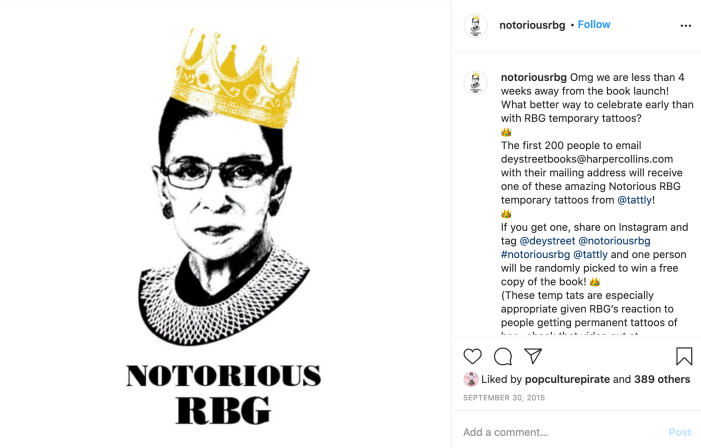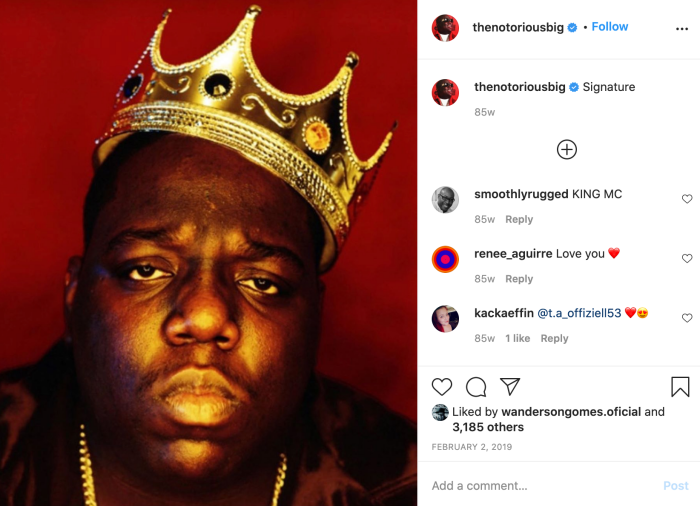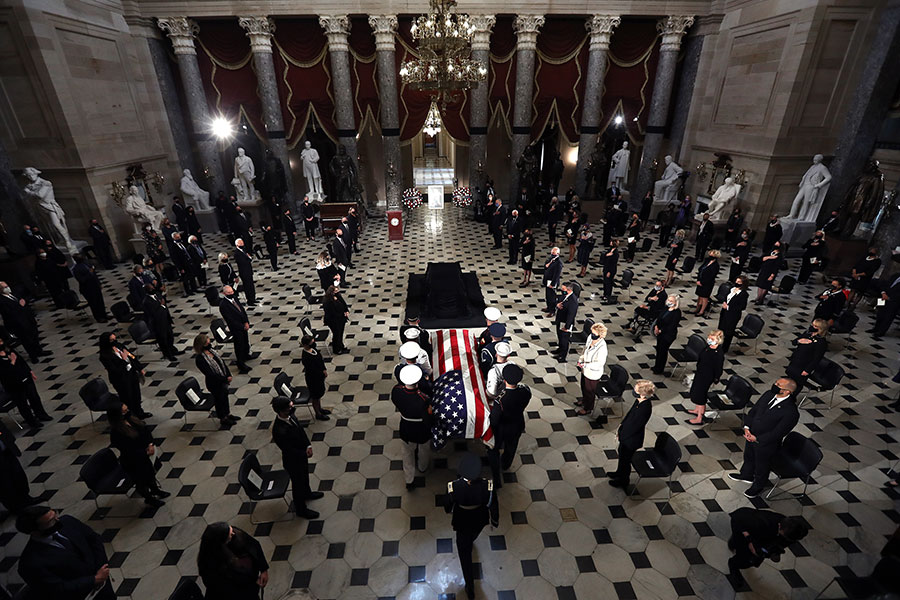How Ruth Bader Ginsburg Won Over Millennials and Made Feminism Cool Again

Ruth Bader Ginsburg championed women's rights throughout her life, and her commitment to feminism transcended generations. Photo: EPA/Matthew Cavanaugh/Canadian Press
Like everyone else, I burst into tears. I turned my TV onto CNN last Friday and there was the chyron: “Ruth Bader Ginsburg, dead at 87.” No other news has ever made me cry so instantaneously. I was crying before I knew I was. Because among her countless accomplishments, there’s one I’m particularly grateful for: Ginsburg saved feminism.
I was born in 1962, raised by a mother who couldn’t get the gas bill changed to her name after my parents divorced. When my daughter was born — just five months before Ginsburg became the second woman ever to take a seat on Supreme Court, in August 1993 — I tried to instil in her the knowledge that marginalized people only had rights because they fought for them, and that those fights were ongoing.
But millennials are skeptics; they saw only the flaws (admittedly considerable) in white feminism. They felt the movement had failed, and they took for granted the gains. Which was the point of the struggle — they should feel entitled to equity — but still. The rejection of the word pained me.
Ginsburg was a famously clear and vivid writer who edited and re-edited every word of her opinions to ensure that laypeople and not just lawyers could understand them. For example, she wrote that trashing the Voting Rights Act simply because it was working to lessen discrimination was like “throwing away your umbrella in a rainstorm because you’re not getting wet.”
And then, that unique writing style and her opinions led to a weirdly miraculous happening. In June 2013, a law student at NYU named Shana Knizhnik started a blog called Notorious R.B.G. that quoted some of Ginsburg’s more incendiary dissents in her three decades as a U.S. Supreme Court justice.
The moniker, of course, was a play on the name of late rapper Biggie Smalls, also known as Notorious B.I.G. — who was murdered in 1997 in a drive-by shooting at age 24 — and the image of Ginsburg wearing a crown inspired by the famous image of Smalls wearing a crown.


“People ask me, don’t you feel uncomfortable with a name like the Notorious B.I.G.?,” Ginsburg noted in 2017, when asked about the nickname. “Why should I feel uncomfortable? We have a lot in common. And first and foremost, we were both born and bred in Brooklyn, New York.”
And today, Smalls’ son, C.J. Wallace, said in a statement to Today that, “Brooklyn, New York, represents no fear, confidence, and speaking your truth, and my dad and Justice Ginsburg lived those words. I think he would be honoured to share the ‘Notorious’ title with her, and it’s up to us to honour their legacies by continuing to fight for equality and justice for all by voting and getting into good trouble.”
The blog, meanwhile, went viral, the 2,000 RBG T-shirts that Knizhnik made flew out her door and in 2015 the book she co-authored with Irin Carmon, Notorious RBG: The Life and Times of Ruth Bader Ginsburg, became an instant New York Times bestseller.
At the same time, millennials were moving into the work world and being smacked in the face by the inequities they found there. Women were still marginalized, still paid less, still not invited into the club. Donald Trump was elected in 2016 despite numerous allegations of sexual assault and despite his own admission that he grabbed women’s genitals. (In a rare break from her apolitical protocol, Ginsburg spoke out against Trump. The day after his inauguration, her visage graced placards in women’s marches all over the world.) The #MeToo movement, which had been brewing since Tarana Burke coined the term in 2006, exploded in 2017 when the Harvey Weinstein story broke. #TimesUp and #RapedNotReported followed, and maybe helped millennials realize why boomers kept using the word “Feminist.”
Taking Notice of Ginsburg
The millennials’ growing awareness and Ginsburg’s rise to fame dovetailed and fed one another until they were one and the same. Young women learned that the reason they had a credit card in their own name or could rent a home or consent to medical treatments or be pregnant at work without fearing for their jobs was directly tied to cases Ginsburg had chosen to argue (her tremendous foresight! Her brick-by-brick approach to building a wall of civil rights law!).
In return they lauded her and loved her: as a meme, wearing a Jean-Michel Basquiat crown; on Saturday Night Live, where Kate McKinnon’s impression played up Ginsburg’s indefatigable spirit; on the sitcom The Good Place, where Maya Rudolph’s wise-judge character paid homage; on Stephen Colbert, where Ginsburg out-planked him. Kids played with Ruthie dolls and went trick-or-treating dressed in black robes with white collars. Her face appeared on everything from tattoos to throw pillows to shower curtains. In 2018, when she was battling cancer for the third time — she died Sept. 18, after her fifth bout, from metastatic pancreatic cancer — people offered to donate their organs.
In theatres, watching the documentary RBG (which grossed US$14 million and was nominated for two Oscars) or the biopic On the Basis of Sex — both of which are being re-released today in theatres and on VOD — I saw groups of boomer women lawyers, who came up just behind Ginsburg, cry all the way through. They were 20 years younger than Ginsburg, they lived in Canada, but their experiences were the same.
Like her, they struggled to get jobs. Though Ginsburg graduated first in her class at Columbia Law School, the Supreme Court justice Felix Frankfurter refused to hire her as a clerk and 12 firms rejected her. So she became a law professor at Rutgers and Columbia — the first woman granted tenure at Columbia Law — and then, in 1972, founded the Women’s Rights Project at the American Civil Liberties Union. There she targeted hundreds of U.S. federal laws that discriminated on the basis of sex and argued her most impactful cases.
Like Ginsburg, boomer women were denied recognition. When she argued before the U.S. Supreme Court in 1973 that women in the military should be able to pass their benefits to their families — and won — the New York Times ran a story but didn’t name her.
And like her, they were working on and studying gender equality cases here in Canada, such as 1973’s Murdoch v Murdoch, where four of five (male) justices ruled that Irene Murdoch’s 25 years of ranching alongside her husband did not entitle her to half the property upon their divorce, a ruling that stoked public and political support for property law reform. Or AG v Lavell, which argued that Indigenous women, like Indigenous men, should retain their status even if they married a non-Indigenous person.
Yet, in those movie theatres, young people were weeping just as copiously. In the week since Ginsburg’s death, they’ve driven the avalanche of social media hashtags #RIPRBG and #ThankYouRuth. They’ve posted testimonials, from Lena Dunham (“What she meant for our past was only rivaled by what she still meant for our future”) to Barry Jenkins (“F**K”) to Mindy Kaling (“The kind of scholar and patriot you get excited about explaining to your kids. The kind of person who you say, ‘Who knows, one day you could be HER”). They’ve shared photos of the bronze Fearless Girl statue in front of the New York Stock exchange, wearing one of Ginsburg’s trademark lace collars; of the New Yorker’s next cover (a white lace collar against a stark black background, where the lace is made of repeated Venus symbols, the circle-and-cross graphic that denotes women). They’ve turned Ginsburg’s pithiest quotes into memes: “Women belong in all places where decisions are being made”; “When will there be enough women on the Supreme Court? When there are nine.”
That last remark has become “a bit of a tea-towel quote,” a friend of mine noted, and that’s too bad, because it’s actually revolutionary. It stood thinking on its head. We’ve been accepting all-male institutions for literally millennia, and yet we can’t imagine that an all-female entity could be normal. Ginsburg could.
Many of the posts echo Sarah Silverman’s “Grateful, and very, very scared,” because the wall of law Ginsburg built brick by brick is under assault by Donald Trump — who is insisting he will replace her with a conservative before the Nov. 3 election — and even she, almost-indestructible she, isn’t here to hold it up any more. Someone posted, “I don’t want to live in Gilead,” a reference to the repressive theocracy in Margaret Atwood’s The Handmaid’s Tale.
The posts are from around the world because the fragility of equal-rights law concerns everyone. “Iran’s constitution was based on the U.S. and France,” an Iranian friend wrote, “but with two loopholes that made it possible for radicals to take and abuse power. They managed to use those loopholes. If that happens in the U.S., women’s rights everywhere could easily go back to the Stone Age.”
And then there are the posts I think of as particularly millennial. “If you’re ever afraid to stand out from the norms,” filmmaker Eli Vazquez wrote, “or question yourself in a sea of adversity, think of RBG.” Wrote a young woman, “Life changes if we rebel.”
Every Generation Saw Itself in Ginsburg
That was one of Ginsburg’s superpowers, that every generation saw itself in her. Millennials are willing to embrace feminism, I believe, because the way Ginsburg practiced it feels relevant to them. The way she and her eight fellow female classmates had to defend their right (to the dean himself!) to occupy space at Harvard Law is the same struggle every marginalized person faces. The way Ginsburg and her husband, Marty, a tax attorney who died in 2010, shared domestic duties and the rearing of their two children, Jane and James, is how young people want to live.
Her beliefs — that “we should each be free to develop our own talents, and not be held back by artificial barriers, man-made barriers;” that “men and women will create new traditions by their actions;” and, most crucially, that “if you are neutral in situations of injustice, you have chosen to side with the oppressors” — are their beliefs. Her goal — “I want to be part of the general human rights agenda…[for] the equality of all people” — is their goal.
Like millennials, Ginsburg defended her right to be unpopular, like when she argued that Roe v Wade was the wrong case to uphold abortion (she felt it had too many fragilities and loopholes, and clearly she was correct). She wasn’t afraid to show her anger, either. In 2006, when the Supreme Court ruled against Lilly Ledbetter’s right to equal pay at Goodyear, Ginsburg read her dissent aloud from the bench. (That is not the norm, but it had an effect — in 2009, U.S. President Barack Obama signed the Lilly Ledbetter Fair Pay Act into law.) And she resisted the demands of the patriarchy, like when she declined to retire so Obama could replace her with another liberal before he left office. (Has anyone ever asked that of a man?) She made being a feminist look not only cool but essential.
As well, Ginsburg did not present one monolithic personality but contained multitudes: she was a precise thinker with a giddy sense of humour; her written court opinions were both muscular and spare; she was dogged without being single-minded, demure yet a firebrand; her best friend on the court was the late conservative justice Antonin Scalia; she was a great mother who never apologized for her commitment to her career. That’s also the millennial perspective: each of us is not one thing, our strengths are our weaknesses, we are a continuum.
In her 27 years on the Supreme Court, Ginsburg was often in the minority, but that didn’t stop her. She became famous for her dissents, and dissent is the language of millennials. They know all too well that things fall apart. Ginsburg knew it, too, but she spent her life fighting to make things how they ought to be. She failed and then she tried again. “Go onto the next challenge,” she said, “and give it your all.” Millennials want to believe, against all evidence, that one person can make a difference. Ginsburg was evidence.
It’s fitting that her final thought was for future generations — “My most fervent wish is that I will not be replaced until a new president is installed” — and that the person she expressed it to was her granddaughter, Clara Spera, who is also an attorney.

On Wednesday, 120 former clerks flanked Ginsburg’s casket as it lay in repose at the Supreme Court. Soon, the Brooklyn Municipal Building, in the borough where she was born and raised, will be named for her. Today, she becomes the first woman to lie in state at the U.S. Capitol.
Still breaking barriers, even in death.
RELATED:
Live Strong: Inspirational & Influential Women We’re Looking To on This International Women’s Day
Celebrate Gloria Steinem’s 85th Birthday With a Look Back at Her 1968 Interview With Moses Znaimer